What’s killing Malibu Creek’s steelhead
April 6, 2010
Twice in recent summers, Malibu Creek’s fledging population of endangered steelhead have been decimated, leaving the experts baffled and saddened.
In 2006, hundreds of the fish turned yellow and died after a heat wave that was accompanied by a foul-smelling black layer of rotting algae and bacteria in the stream bed. The ooze earned a nickname: Malibu Muck.
By early 2008, the population of juvenile steelhead managed to edge toward 3,000 again, giving biologists hope that the fish were making a strong comeback.
But last year, the die-offs returned with a vengeance. Steelhead, as well as the hardy carp, crayfish and others, died en masse. The Malibu Muck was back, too. This time, the baby steelhead didn’t turn yellow but the population in the creek still plummeted from about 1,300 to just 200 young fish.
In the bad years, “everything was dying,” says conservation biologist Rosi Dagit. “And we really had absolutely no clue why.”
Last week, Dagit and other conservation biologists waded into the creek to look for answers, launching the most comprehensive water quality study ever undertaken in the crucial Santa Monica Mountains watershed.
 Standing waist deep in Malibu Creek, Steve Williams and Kevin Jonz carefully slid a high-tech measuring device called a sonde inside a plastic housing and dipped it into the algae-green water. They anchored the two-foot cylinder to the creek bed with a steel fence post and then fastened the contraption to a willow thicket with a stout metal chain.
Standing waist deep in Malibu Creek, Steve Williams and Kevin Jonz carefully slid a high-tech measuring device called a sonde inside a plastic housing and dipped it into the algae-green water. They anchored the two-foot cylinder to the creek bed with a steel fence post and then fastened the contraption to a willow thicket with a stout metal chain.
In all, five sondes were installed—four in Malibu Creek and one in nearby Topanga Creek. The devices will gather six vital measures of water quality every 30 minutes, around the clock, from April to October. The thousands of data points on water temperature, clarity, pH, algae levels, conductivity and oxygen levels will provide scientists with a full view of the changes in water quality over an entire season, from the high flows of spring to the slack low water of late summer and fall.
“The overarching question is what [water quality] factors are causing problems for the steelhead recovery,” says Dagit, a senior conservation biologist for the Resource Conservation District of the Santa Monica Mountains and the study’s lead scientist. “If you can find ways to give the fish a chance, then you can grow the population.”
Southern steelhead are sea-going rainbow trout that, like their salmon cousins, return to spawn in the creeks and rivers of their birth. The red-stripped, olive-and-silver fish, which can grow to 35 inches or more, has been in decline since the 1950s and became endangered more than a decade ago.
Thousands of tiny steelhead are born in creeks from San Luis Obispo to Mexico, but few survive to migrate to the Pacific. Today, the total population of adult fish that made it into the ocean off Southern California is estimated at only 500. (A northern subspecies, also endangered, ranges from Central California to Canada.)
If the southern steelhead are to stage a comeback, they’ll need to breed in the deep pools of streams like Malibu Creek, where the young must survive for a couple of years until they’re old enough to head to sea.
Dagit and others believe that the Malibu Muck is at least partially responsible for the carnage. They hope the new study will provide clues to why the muck can be so bad in some years and not in others. At its worst, it’s a carpet of black and white ooze a foot deep in places, coating the entire creek bed. Composed of rotting algae, bacteria and smelling like sulfur, the muck was “ubiquitous” at the time of the die-offs, Dagit says.
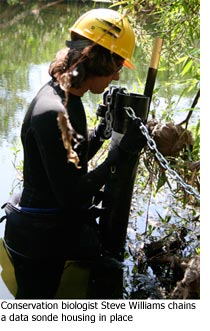 Whatever connects the muck to the fish kills, it’s not as simple as the presence of a simple toxin in the water. An earlier chemical analysis of a muck sample turned up nothing that would account for the deaths, says conservation biologist Sandra Albers.
Whatever connects the muck to the fish kills, it’s not as simple as the presence of a simple toxin in the water. An earlier chemical analysis of a muck sample turned up nothing that would account for the deaths, says conservation biologist Sandra Albers.
Today, steelhead can only travel two miles upstream, where a dam built in the 1920s blocks their path. So the scientists placed two sondes in the steelhead pools in the lowest parts of the creek. Two more will be placed in similar deep pools above the dam to see if conditions in the lower creek are significantly different. The sonde in Topanga Creek—a stream that also supports a small steelhead population—was placed there as a way to compare its healthier waters with those of Malibu Creek.
Albers and others will download the data every month via handheld devices that plug into the sondes, four of which are on loan from the Southern California Coastal Water Research Project and the other from the Las Virgenes Water District. Supervisor Zev Yaroslavsky’s office has committed $8,000 to help cover the project’s costs.
No one is expecting a simple fix. But the hope is that scientists can develop a new hypothesis by combining the data with ongoing studies of steelhead counts, algae populations and the proliferation of a tiny invasive pest called the New Zealand mud snail.
Still, the scientists believe they’ll find useful information that will someday allow steelhead to grow up in Malibu Creek once again in significant numbers.
“There are a couple of pieces of the puzzle that we don’t have a handle on,” says fish biologist Carl Demetropoulos, an environmental consultant who volunteers his time to help with the study and fondly remembers catching small steelhead with his dad in Malibu and Topanga in the mid-1960s. “Steelhead are really adaptable and the best hope is that they are already able to come back.”
Posted 4/6/10
Students take the poll position
April 6, 2010
 Who says democracy is only for the 18-and-older crowd? And who says teenagers are a cynical bunch?
Who says democracy is only for the 18-and-older crowd? And who says teenagers are a cynical bunch?
More than 2,500 Los Angeles County teenagers are expected to dip their toes into the waters of political awareness on June 8 by volunteering at polling places for the California primary elections. The county’s popular Student Poll Worker Program is open to public and private school students who are at least 16, are U.S. citizens, have a minimum grade point average of 2.5 and have parental and teacher consent.
But wait, there’s more.
Student volunteers will receive a stipend of up to $105 after completing a two-hour training session and their election-day duties. The stipend can also be exchanged for school community service credit. According to teacher coordinators, the money is well spent.
“When I tell them they can earn $100, that’s a lot of money,” says Stan Bartosiak, a social studies teacher at Glendale High School who has been a local coordinator for the program for the past four years.
“But once they’ve done it, it’s such an overwhelming civic experience. Their perceptions change, no doubt about it. They get to work as adults in a situation that’s rarely available to them,” Bartosiak says, adding: “If we can get life-long voters, 100 bucks per kid is a great investment,”
Bartosiak, who has taught at Glendale High for two decades, is so committed to making sure his students become voters that he holds 18th birthday celebrations for them in class and registers them to vote on the spot.
Blanca Casarrubias, countywide outreach manager for Student Poll Worker Program, said she had 37,500 total student volunteers in the November, 2008, elections and expects more than 3,000 in November, 2010. Students are placed in polling sites within their neighborhoods and work from 6:00 a.m. until approximately 9:30 p.m.
Casarrubias says there are unique benefits for bringing students on board. Many, she said, are bilingual, technologically savvy and sometimes more dependable than adults because they have made the commitment through teachers and parents. And, Casarrubias noted, they can carry heavy election supplies.
Registration must be completed via the school’s designated teacher coordinator and be completed by April 9. Details about registration are available here.
Posted 4/06/10
A plan to help homeowners go green and save green
April 1, 2010
 Property owners in Los Angeles will find it easier and more affordable to “go green” with energy-efficient and water-saving equipment installations under a new program considered for adoption this week by the Board of Supervisors.
Property owners in Los Angeles will find it easier and more affordable to “go green” with energy-efficient and water-saving equipment installations under a new program considered for adoption this week by the Board of Supervisors.
Thanks to AB 811, a state law enacted in 2008, local governments may establish programs that allow property owners to finance renewable energy and resource-efficiency retrofits through voluntary assessments on their property tax bills. Unlike similar previous efforts to spur renewable-energy investments, however, this innovative strategy removes two key barriers that hampered earlier programs.
By allowing property owners to take out energy-efficiency loans and pay them back over time, the program does away with property owners’ significant up-front personal investment. At the same time, it removes their back-end liability for costly improvements that have yet to pay off in energy savings because after a property is sold, the loan stays with the new buyer, not with the previous owner. Because the new owners will continue reaping the benefits of the energy efficient installations, they will fairly assume the existing loan obligation.
County officials estimate that during the program’s first two years, some 15,000 homes could be retrofitted, pumping $150 million into the local economy and creating as many as 2,600 green-related jobs. And the environment would benefit, too: all those energy-efficient and water-saving systems could help the state and County reduce greenhouse gas emissions by 20,000 tons of carbon dioxide annually.
Posted 4/1/10
A show of wings at L.A. museum
April 1, 2010
The California Dogface is getting ready for its close up. So are the Mourning Cloaks, Giant Swallowtails and Red Admirals.
A cast of hundreds of moths and butterflies are about to alight, oh so delicately, at L.A. County’s Natural History Museum when the annual Pavilion of Wings opens April 11. More than 40 different species will star in the 5-month show, held in a giant tent on the museum’s south lawn.
Last year’s exhibition attracted more than 65,000 visitors during its run. Tickets cost $3 for adults, $2 for seniors and students and $1 for children ages 5-12. Visitors under 5 are admitted for free.
For organizers, there’s no winging this kind of show, says museum entomologist Brent “the Bug Guy” Karner, the exhibit’s impresario for the past 10 years. He says it takes months of intricate planning, including a lot of overnight shipments and preparation for the show’s final act—the appearance of hundreds of ravenous spiders.
Logistics for this one started in January, when Karner and his crew of naturalists placed orders from “butterfly farms” in Texas, Florida and California. The farms attract butterflies and moths by planting flowers, shrubs and trees on which the various species lay eggs. Farmers then nurse them through the early stages of life: egg, caterpillar and chrysalis, which is the immobile, hard-coated pupa stage before adulthood.
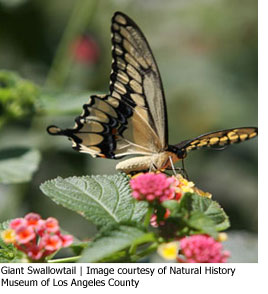 Beginning this week, boxes of chrysalises will begin arriving in overnight deliveries. Karner’s entomologists will carefully place the chrysalises in mesh cages indoors until they metamorphose into adults and are ready to be transferred to the tent, filled with dozens of plants and flowers that attract the flying beauties.
Beginning this week, boxes of chrysalises will begin arriving in overnight deliveries. Karner’s entomologists will carefully place the chrysalises in mesh cages indoors until they metamorphose into adults and are ready to be transferred to the tent, filled with dozens of plants and flowers that attract the flying beauties.
Because moths and butterflies don’t survive long as adults—most die after 3 to 4 weeks—Karner keeps weekly shipments coming throughout the show’s run, ending in September.
To ensure a big opening day crowd, he also orders shipments of live adults, which are sealed in envelopes packed inside boxes. “So long as you send them overnight,” Karner says, “they’ll all be fine on our end.”
All of the species are from the U.S., with about half native to California. The California dogface, so called because of a white mark on its wings that looks like a canine’s mug, is the official state insect. Among this year’s newbies is the Small Postman, a tropical pollen-eating butterfly from south Texas. Karner says he’s also increased the quotient of moths, which he believes deserve equal billing. “Butterflies are just day-flying moths,” Karner sniffs. They include Hawk moths, who hover and dart like birds of prey.
Karner and the museum staff use the moths and butterflies to teach about insect evolution and to explore the relationships between insects and the plants they eat as caterpillars and use as breeding grounds. “Those lessons make the experience at our butterfly pavilion much deeper than most others,” he says. “It’s pretty darned cool.”
Come September, one last drama of nature will unfold in the tent and out of public view as the fall spider show prepares to move in. The winged stars quickly become arachnid lunch. “The spiders take care of all my butterflies,” says Karner. “Unfortunately, people don’t get to see the massive onslaught.”
Maybe that’s just as well.
Posted 4-01-10




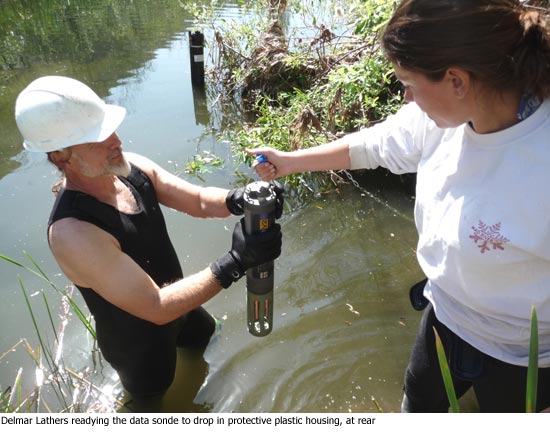
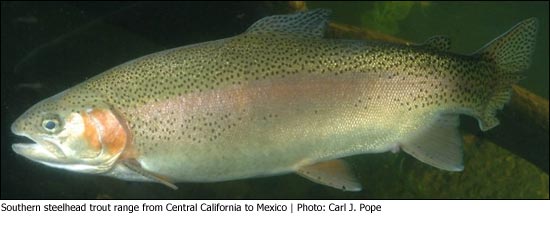

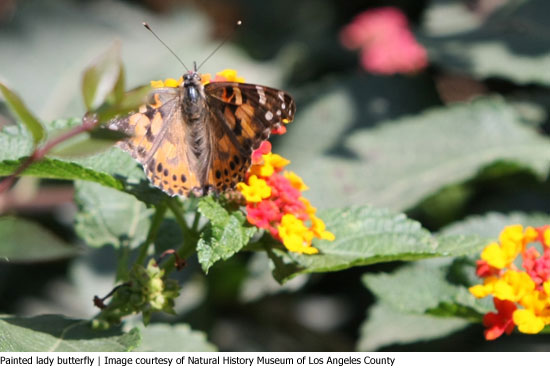






 Check for the latest closure information
Check for the latest closure information








